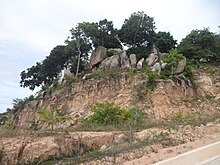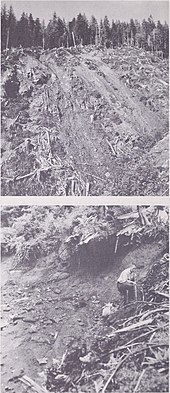94:
20:
71:
150:
processes that have occurred in a specific geological setting. Alluvium is sand, clay, or other similar detrital material deposited by running water. The distinction between colluvium and alluvium relates to the involvement of running water. Alluvium specifically refers to the geomorphic processes
113:
change based on the paleosols and the remains of plants and animals, invertebrate and vertebrates that they often contain. These fossils indicate previous geologic and environmental settings. Thick accumulations of colluvium often contain well-preserved and sometimes deeply buried archaeological
85:
refers to the buildup of colluvium at the base of a hillslope. Colluvium is typically loosely consolidated angular material located at the base of a steep hill slope or cliff. Colluvium accumulates as gently sloping aprons or fans, either at the base of or within gullies and hollows within
134:
and so can indicate past stages of cooler and/or wetter weather. Deposits of detrital colluvium can reveal the soil composition and signify processes of chemical weathering.
315:
304:
46:, or a variable combination of these processes. Colluvium is typically composed of a heterogeneous range of rock types and sediments ranging from
155:
in water currents and eventually deposited. For these same reasons, alluvium is also generally well sorted material while colluvium is not.
54:
fragments of various sizes. This term is also used to specifically refer to sediment deposited at the base of a hillslope by unconcentrated
146:
are interdependent and reliant on one another. Distinctions between the two are important in order to properly define the
151:
involved with flowing water and so alluvium is generally fine-grained clay and silt material that has the capacity to be
217:
235:
in A. S. Goodie, ed., pp. 173, Encyclopedia of
Geomorphology Volume 1, A–I. Routledge, New York, New York. 1200 pp.
152:
312:
164:
86:
hillslopes. These accumulations of colluvium can be several meters in thickness and often contain buried soils (
299:
93:
42:
that have been deposited at the base of hillslopes by either rainwash, sheetwash, slow continuous
127:
340:
335:
119:
8:
115:
271:
246:
The
Cherokee Excavations: Holocene Ecology and Human Adaptations in Northwestern Iowa.
213:
319:
308:
43:
55:
51:
19:
261:
Research Series. vol. 8. Center for
American Archeology, Kampsville, Illinois.
329:
147:
110:
97:
123:
109:
Thick accumulations of colluvium may preserve a rich record of long term
272:"colluvium | rock detritus and soil accumulated at the foot of a slope"
130:. Colluvium can also be rocks that have been transported downward from
16:
Loose, unconsolidated sediments deposited at the base of a hillslope
184:
169:
143:
87:
39:
179:
174:
131:
59:
259:
Koster site archaeology I: stratigraphy and landscape evolution.
70:
212:
American
Geological Institute, Alexandria, Virginia. 800 pp.
189:
75:
47:
322:, Natural Environment Research Council, United Kingdom.
202:
327:
90:), crude bedding, and cut and fill sequences.
38:) is a general name for loose, unconsolidated
227:
225:
208:Jackson, JA, J Mehl, and K. Neuendorf (2005)
313:Soil Analysis Support System for Archaeology
238:
301:Field Analysis:Is this a colluvial deposit
222:
251:
92:
69:
18:
137:
78:accumulation is an example of colluvium
328:
13:
244:Anderson, D, and HA Semken (1980)
14:
352:
292:
142:The definitions of colluvium and
165:Colluvium-filled bedrock hollow
264:
1:
195:
114:deposits as excavated at the
104:
7:
158:
65:
10:
357:
248:Academic Press, New York.
23:Erosion on Koh Tao Island
276:www.merriam-webster.com
128:Greene County, Illinois
101:
79:
24:
120:Cherokee County, Iowa
96:
73:
22:
138:Compared to alluvium
210:Glossary of Geology
116:Cherokee Sewer Site
318:2013-02-25 at the
307:2019-06-08 at the
231:Goodie, AS (2003)
102:
80:
32:colluvial material
25:
298:Anonymous (2007)
100:in coastal Alaska
348:
286:
285:
283:
282:
268:
262:
257:Angel JR (1990)
255:
249:
242:
236:
229:
220:
206:
356:
355:
351:
350:
349:
347:
346:
345:
326:
325:
320:Wayback Machine
309:Wayback Machine
295:
290:
289:
280:
278:
270:
269:
265:
256:
252:
243:
239:
230:
223:
207:
203:
198:
161:
140:
107:
68:
44:downslope creep
17:
12:
11:
5:
354:
344:
343:
338:
324:
323:
294:
293:External links
291:
288:
287:
263:
250:
237:
221:
200:
199:
197:
194:
193:
192:
187:
182:
177:
172:
167:
160:
157:
139:
136:
106:
103:
67:
64:
56:surface runoff
36:colluvial soil
15:
9:
6:
4:
3:
2:
353:
342:
341:Sedimentology
339:
337:
336:Geomorphology
334:
333:
331:
321:
317:
314:
310:
306:
303:
302:
297:
296:
277:
273:
267:
260:
254:
247:
241:
234:
228:
226:
219:
218:0-922152-76-4
215:
211:
205:
201:
191:
188:
186:
183:
181:
178:
176:
173:
171:
168:
166:
163:
162:
156:
154:
149:
145:
135:
133:
129:
125:
121:
117:
112:
111:paleoclimatic
99:
95:
91:
89:
84:
77:
72:
63:
61:
57:
53:
49:
45:
41:
37:
33:
29:
21:
300:
279:. Retrieved
275:
266:
258:
253:
245:
240:
232:
209:
204:
141:
108:
98:Mass wasting
83:Colluviation
82:
81:
35:
31:
27:
26:
124:Koster Site
330:Categories
281:2015-12-13
196:References
148:geomorphic
122:, and the
105:Importance
233:Colluvium
153:entrained
88:paleosols
58:or sheet
40:sediments
28:Colluvium
316:Archived
305:Archived
185:Illuvium
170:Diluvium
159:See also
144:alluvium
132:glaciers
66:Location
180:Erosion
175:Eluvium
60:erosion
216:
30:(also
190:Scree
76:talus
74:This
214:ISBN
52:rock
48:silt
50:to
34:or
332::
311:,
274:.
224:^
126:,
118:,
62:.
284:.
Text is available under the Creative Commons Attribution-ShareAlike License. Additional terms may apply.


